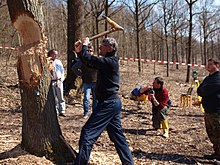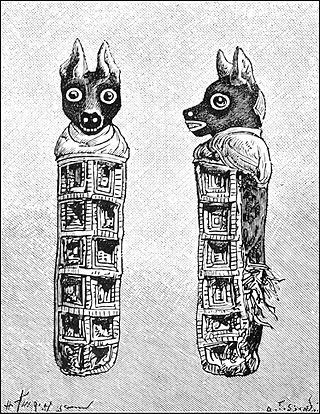
Zooarchaeology, also known as faunal analysis, is a branch of archaeology that studies remains of animals from archaeological sites. Faunal remains are the items left behind when an animal dies. These include bones, shells, hair, chitin, scales, hides, proteins and DNA. Of these items, bones and shells are the ones that occur most frequently at archaeological sites where faunal remains can be found. Most of the time, a majority of these faunal remains do not survive. They often decompose or break because of various circumstances. This can cause difficulties in identifying the remains and interpreting their significance.
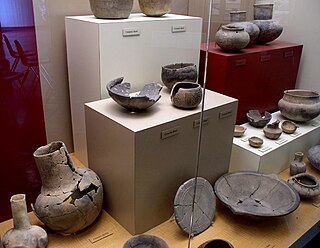
Processual archaeology is a form of archaeological theory that had its beginnings in 1958 with the work of Gordon Willey and Philip Phillips, Method and Theory in American Archaeology, in which the pair stated that "American archaeology is anthropology, or it is nothing", a rephrasing of Frederic William Maitland's comment: "My own belief is that by and by, anthropology will have the choice between being history, and being nothing." The idea implied that the goals of archaeology were, in fact, the goals of anthropology, which were to answer questions about humans and human culture. That was a critique of the former period in archaeology, the cultural-history phase in which archaeologists thought that any information that artifacts contained about past people and past ways of life would be lost once the items became included in the archaeological record. All they felt could be done was to catalogue, describe, and create timelines based on the artifacts.
Post-processual archaeology, which is sometimes alternately referred to as the interpretative archaeologies by its adherents, is a movement in archaeological theory that emphasizes the subjectivity of archaeological interpretations. Despite having a vague series of similarities, post-processualism consists of "very diverse strands of thought coalesced into a loose cluster of traditions". Within the post-processualist movement, a wide variety of theoretical viewpoints have been embraced, including structuralism and Neo-Marxism, as have a variety of different archaeological techniques, such as phenomenology.
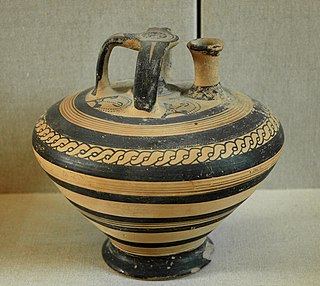
An artifact or artefact is a general term for an item made or given shape by humans, such as a tool or a work of art, especially an object of archaeological interest. In archaeology, the word has become a term of particular nuance and is defined as an object recovered by archaeological endeavor, which may be a cultural artifact having cultural interest.
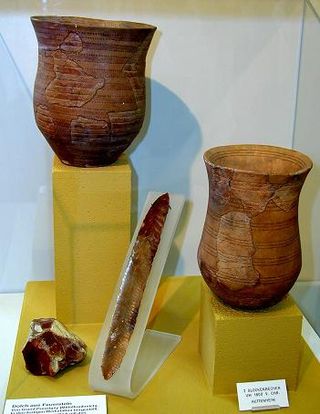
Culture-historical archaeology is an archaeological theory that emphasises defining historical societies into distinct ethnic and cultural groupings according to their material culture.
Environmental archaeology is a sub-field of archaeology which emerged in 1970s and is the science of reconstructing the relationships between past societies and the environments they lived in. The field represents an archaeological-palaeoecological approach to studying the palaeoenvironment through the methods of human palaeoecology. Reconstructing past environments and past peoples' relationships and interactions with the landscapes they inhabited provides archaeologists with insights into the origin and evolution of anthropogenic environments, and prehistoric adaptations and economic practices.
Feminist archaeology employs a feminist perspective in interpreting past societies. It often focuses on gender, but also considers gender in tandem with other factors, such as sexuality, race, or class. Feminist archaeology has critiqued the uncritical application of modern, Western norms and values to past societies. It is additionally concerned with increasing the representation of women in the discipline of archaeology, and reducing androcentric bias within the field.
Cognitive archaeology is a theoretical perspective in archaeology that focuses on the ancient mind. It is divided into two main groups: evolutionary cognitive archaeology (ECA), which seeks to understand human cognitive evolution from the material record, and ideational cognitive archaeology (ICA), which focuses on the symbolic structures discernable in or inferable from past material culture.
Archaeological theory refers to the various intellectual frameworks through which archaeologists interpret archaeological data. Archaeological theory functions as the application of philosophy of science to archaeology, and is occasionally referred to as philosophy of archaeology. There is no one singular theory of archaeology, but many, with different archaeologists believing that information should be interpreted in different ways. Throughout the history of the discipline, various trends of support for certain archaeological theories have emerged, peaked, and in some cases died out. Different archaeological theories differ on what the goals of the discipline are and how they can be achieved.
Michael Brian Schiffer is an American archaeologist and one of the founders and pre-eminent exponents of behavioral archaeology.
The archaeological record is the body of physical evidence about the past. It is one of the core concepts in archaeology, the academic discipline concerned with documenting and interpreting the archaeological record. Archaeological theory is used to interpret the archaeological record for a better understanding of human cultures. The archaeological record can consist of the earliest ancient findings as well as contemporary artifacts. Human activity has had a large impact on the archaeological record. Destructive human processes, such as agriculture and land development, may damage or destroy potential archaeological sites. Other threats to the archaeological record include natural phenomena and scavenging. Archaeology can be a destructive science for the finite resources of the archaeological record are lost to excavation. Therefore, archaeologists limit the amount of excavation that they do at each site and keep meticulous records of what is found. The archaeological record is the physical record of human prehistory and history, of why ancient civilizations prospered or failed and why those cultures changed and grew. It is the story of the human world.
Contemporary archaeology is a field of archaeological research that focuses on the most recent past, and also increasingly explores the application of archaeological thinking to the contemporary world. It has also been referred to as the archaeology of the 'contemporary past'. The use of this term in the United Kingdom is particularly associated with the Contemporary and Historical Archaeology in Theory (CHAT) conference group. The field forms part of historical archaeology, or the archaeology of the modern period. Unlike ethnoarchaeology, contemporary archaeology studies the recent and contemporary past in its own right, rather than to develop models that can inform the study of the more distant past.

Archaeology or archeology is the study of human activity through the recovery and analysis of material culture. The archaeological record consists of artifacts, architecture, biofacts or ecofacts, sites, and cultural landscapes. Archaeology can be considered both a social science and a branch of the humanities. It is usually considered an independent academic discipline, but may also be classified as part of anthropology, history or geography.
In archaeology, phenomenology is the application of sensory experiences to view and interpret an archaeological site or cultural landscape in the past. It views space as socially produced and is concerned with the ways people experience and understand spaces, places and Landscapes. Phenomenology became a part of the Post-processual archaeology movement in the early 1990s and was a reaction to Processual archaeology's proposed 'scientific' treatment of space as an abstract and empty locus for action. In contrast, phenomenology proposes a 'humanized' space which is embedded with meaning and is created through praxis. Phenomenology therefore treats the landscape as a network of places, each of which bears meaning and is connected through movements and narratives.
Marxist archaeology is an archaeological theory that interprets archaeological information within the framework of Marxism. Although neither Karl Marx nor Friedrich Engels described how archaeology could be understood in a Marxist conception of history, the archaeological theory was developed by Soviet archaeologists in the Soviet Union during the early twentieth century. Marxist archaeology quickly became the dominant archaeological theory within the Soviet Union, and subsequently spread and was adopted by archaeologists in other countries. In particular, in the United Kingdom, where the theory was propagated by an influential archaeologist V. Gordon Childe. With the rise of post-processual archaeology in the 1980s and 1990s, forms of Marxist archaeology were once more popularised amongst the archaeological community.
Household archaeology has a long history of anthropological inquiry. Archaeological investigations of the household serve as a microcosm for the greater social universe. The household serves as a space for socialization processes. Household archaeology focuses on the household as a social unit, and involves research on the household's dwelling and other related architecture, material culture, features, and larger sociopolitical organizations that are associated with a specific culture. Household social relationships have been associated as serving as an "atom" for society. Therefore, household studied effectively convey information pertaining to flexible economic and ecological conditions Household activity encompasses spheres of activity related to function and how people act. Household archaeology redefines the notion of the household and the domestic by challenging notions of what households are, how they operate and the social implications of such analysis. The material culture provides information about such activities. Households are families, domestic groups, and co-habitations. Households function in a variety of fashions.
The social sciences are the sciences concerned with societies, human behaviour, and social relationships.
The philosophy of archaeology seeks to investigate the foundations, methods and implications of the discipline of archaeology in order to further understand the human past and present.
There are two main approaches currently used to analyze archaeological remains from an evolutionary perspective: evolutionary archaeology and behavioral ecology. The former assumes that cultural change observed in the archaeological record can be best explained by the direct action of natural selection and other Darwinian processes on heritable variation in artifacts and behavior. The latter assumes that cultural and behavioral change results from phenotypic adaptations to varying social and ecological environments.
Neuroarchaeology is a sub-discipline of archaeology that uses neuroscientific data to infer things about brain form and function in human cognitive evolution. The term was first suggested and thus coined by Colin Renfrew and Lambros Malafouris.
